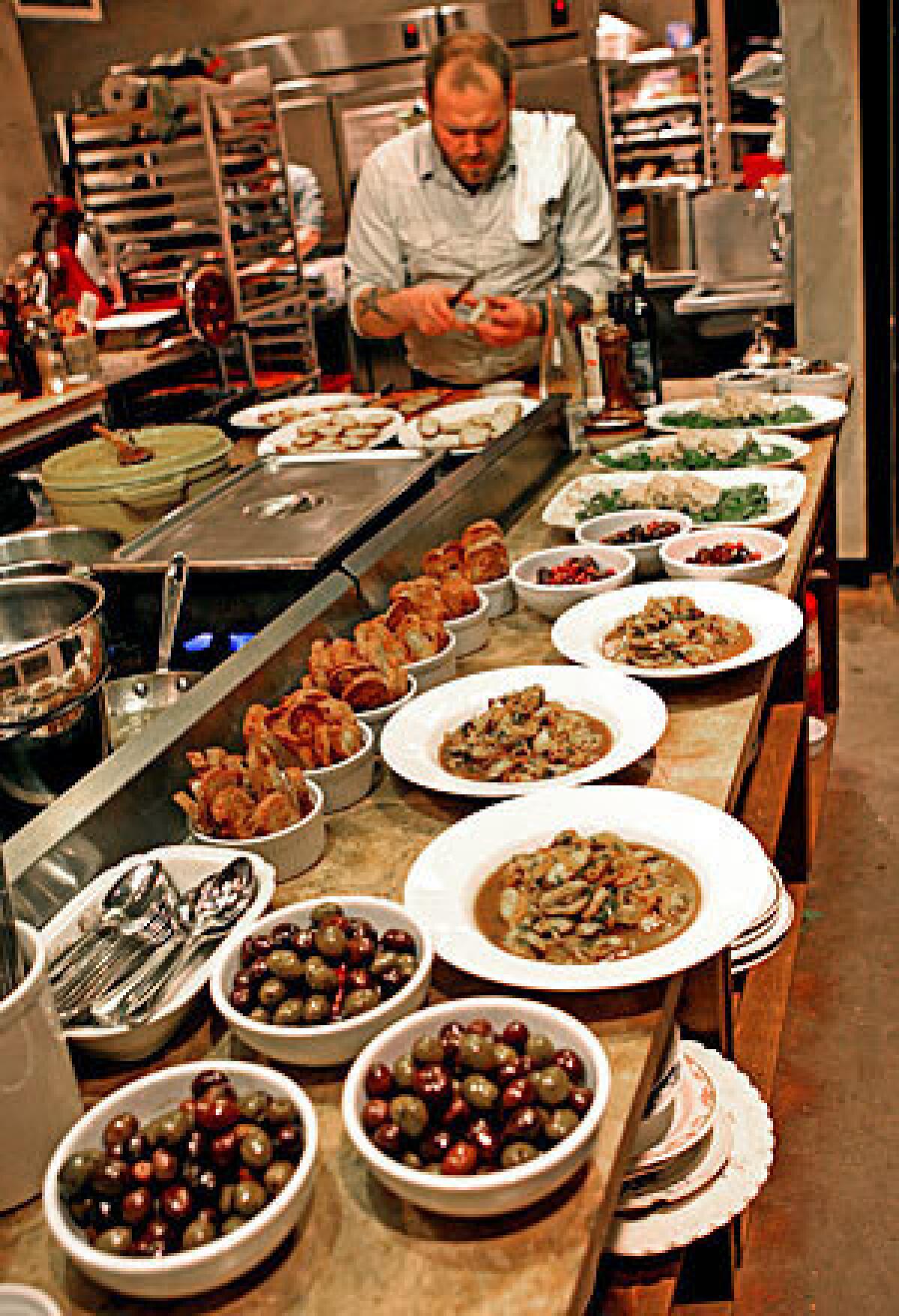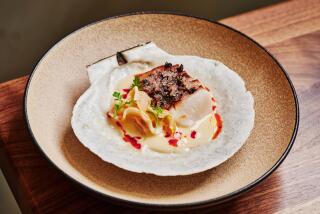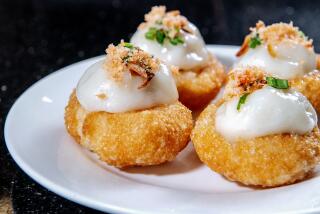Restaurant reviews: Corson Building and Cascina Spinasse in Seattle

The theme here these days is young chefs moving into outlying and up-and-coming neighborhoods to open small restaurants built with lots of passion and elbow grease. On a recent visit, I ate white bean and duck confit soup at Skillet, a roving Airstream trailer parked at a different place every day, and spectacular fresh fried fish and chips at a hole-in-the-wall called -- what else? -- Fish Fry.
The two restaurants I’d heard most about, the Corson Building and Cascina Spinasse, turned out to be well worth a jaunt north, with dedicated young chefs -- Matt Dillon and Justin Neidermeyer -- who have each created a restaurant with heart, soul and terrific food, yet both are completely unlike anything in L.A.
Built circa 1910 by a family of Italian stonemasons, the Corson Building needed some tender loving care, to say the least. Dillon, of the wildly popular Sitka & Spruce, and friends restored the interior, uncovering a charming fireplace crowned with a lion’s head, and added a large new kitchen in the back with a view of the soccer field across the way. They built a tall wood-burning oven outside, a brick patio, and raised beds for herbs and vegetables. There’s a chicken coop in one corner of the garden, beehives in another, and fig, plum and peach trees.
We enter the fenced garden through a gate where a bin of apples sits -- what is left from the community cider pressing they’d held the week before. Inside is that lovely fireplace and a charming dining room with arched windows and three long communal tables that seat 32 at full capacity. Dillon’s partner, Wylie Bush, is the host and takes our coats and serves us perfect kir apéritifs. We look around as we wait for the other guests to arrive, sussing out the cookbook library, the collection of wine bottles arranged on a sideboard (that’s the wine list), and the kitchen with its massive stove and long wooden counter for making pasta.
Dillon and his co-chef, Emily Crawford, are scrubbing scallop shells (they’d bought the scallops live that morning) and plating up a shimmering elk shin aspic. “Someone gave us an elk leg yesterday, and so we boned it out and made this aspic,” Dillon explains later when he introduces the menu in the dining room. “Come into the kitchen later to chat, “ he tells everyone. “We get lonely back there.”
We settle down at the table, 10 or 12 of us all together, and the feast begins. First is superb duck rillettes, rich and unctuous, passed, like almost everything else, family-style, to spread on homemade Melba toasts. Next is that wonderful elk shin aspic with an arugula salad and pickled Japanese radishes. Diced apple, spigarello (an Italian green) and shaved Brussels sprouts showered with caraway come with sautéed clams in the shell.
So many flavors
A platter of deep-flavored quail roasted in the wood-burning oven and served with heaps of salsify and parsnip chips is passed next, followed by those sweet-tasting scallops cooked in their shells with beer and preserved lemon.
Pace yourself, we keep saying, as we gobble up every last bit and, in too many cases, go for seconds. Because there’s much more to come. Namely, some of the best gnocchi I’ve had this side of Italy -- small, delicate ovals tossed in butter made from the same milk that goes into Parmigiano-Reggiano cheese, with Washington black truffles shaved over. The truffles add more crunch and visual than taste, but are lovely nonetheless.
The pièce de résistance is a generous platter of short ribs braised on the bone in some of that cider made the week before, accompanied by half-rounds of delicata squash and glorious chanterelles in a honey and cider vinegar gastrique. We’re passing dishes, sharing wines, changing places the better to get in on one conversation or another, so involved we forget to go visit the cooks in the kitchen.
Dessert is a dreamy pumpkin clafouti in individual pots topped with what Dillon calls “aerated” cream, whipped just enough to give it some lift. To finish, we have coffee and chocolates from artisan producer Claudio Corallo.
A slice of Piedmont
I’ve been waiting for Cascina Spinasse to open ever since I was in Italy in the Piedmont and heard about this Seattle kid whom “Cinto” Albarello, a master pasta maker, had taken under his wing and taught to make the region’s famous tajarin (tagliatelle made with an astonishing ratio of egg yolks to flour). Justin Neidermeyer didn’t do a three-day stage: He stayed on in Barbaresco for nearly a year, learning under the master’s watchful eye. The kid had the touch, Albarello boasted to everyone who came to eat at Antica Torre. For a while after Neidermeyer went home to Seattle, he was selling his pasta at the farmers market. Now, finally, he has his own restaurant.
Neidermeyer has taken a decrepit storefront and turned it into a restaurant that feels like one in any of the hill towns outside Alba. Look for the logo stenciled onto the glass out front, a coat of arms featuring his favorite tools -- a pasta cutting wheel and a ribbed board for making gnocchi.
What he is making is real Piedmontese food. Start with a few antipasti, maybe salt-cured anchovies in salsa verde strewn with chopped hard-boiled egg yolk, a beautiful salad of heirloom chicory, radicchio and rabbit loin with shaved Parmigiano-Reggiano and a dash of real aceto balsamico. And then maybe crostini topped with sautéed rabbit liver and a few drops of the sweet vinegar. I couldn’t resist the romanesco broccoli in bagna cauda with some local truffles shaved over.
But the real deal here is the pasta -- handmade, hand-cut to fine, golden strands and sauced simply in butter and sage -- and, in season, white truffles -- or else in a light meat ragu, which tastes exactly the way Albarello used to serve it in Barbaresco. (He passed away a couple of years ago, and his photograph hangs on the wall as patron saint of Cascina Spinasse.) I could easily order a plate of each pasta.
Main course: pasta
We also tried maltagliati with puntarelle (a bitter green) and local black truffles. Maltagliati means “badly cut”: It’s unevenly cut pasta shapes, like wide, ragged noodles. And since Neidermeyer made ravioli stuffed with pumpkin that night, we had to try that too. His dough is so thin it’s practically transparent and drapes like silk around the simple pumpkin filling.
Because the focus of Cascina Spinasse is pasta, there are only two, occasionally three, main courses, and I respect him for that restraint. They change all the time.
The night I went, he had quail with lentils and a delicious, subtle braised rabbit with carrots, potatoes and rosemary. But the choices could as easily have been porchetta, a braised duck, or sausage balls wrapped in caul fat.
Lately, he’s been getting into gargantuan cuts of meat, such as a whole roasted pork leg. We could have finished with a Piedmontese cheese, but we were already bursting at the seams. Instead, we had a half bottle of Moscato d’Asti and one order of Bosc pears, roasted, and served in a little honey and delicious cream.
More to Read
Sign up for our L.A. Times Plants newsletter
At the start of each month, get a roundup of upcoming plant-related activities and events in Southern California, along with links to tips and articles you may have missed.
You may occasionally receive promotional content from the Los Angeles Times.






